The worst thing about the language barrier by a WIDE margin here in Thailand is that it limits me from trying different food. Seriously. I’ve been to about 2592805 staff dinners at this point, and there’s still something that surprises me everytime. If you’ve tried som tam(spicy papaya salad), did you know that there’s a fried version? It’s called som tam tohd if you ever get the chance to try it, it’s a religious experience.
So after 7 months of being here, this is the best advice I can give you with navigating street stalls in Thailand. Street stalls where there either a) isn’t a menu, b) the menu isn’t in English, c) the people running the stall don’t speak English, or d) all of the above, AKA lunch in Dan Chang.
-
Point and act a fool

This one is number one because it’s IMPORTANT. Use your body language and be dramatic so the people can figure out what you’re talking about. While everyone uses body language, not all body language has the same universal meaning. So the more cues you give, the better.
When I don’t know what a stall offers but I want to try(I like to think I’m an adventurous eater), I point at what someone else is eating and say “Uhh neeee, neung.”
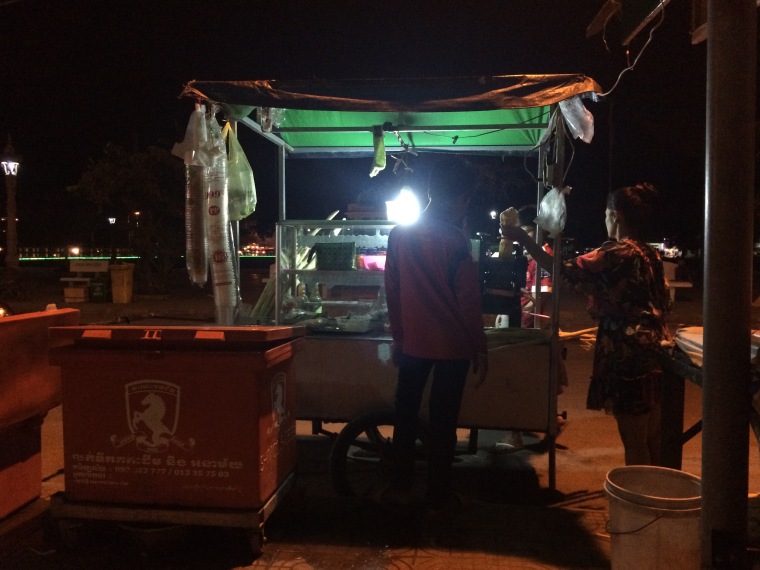
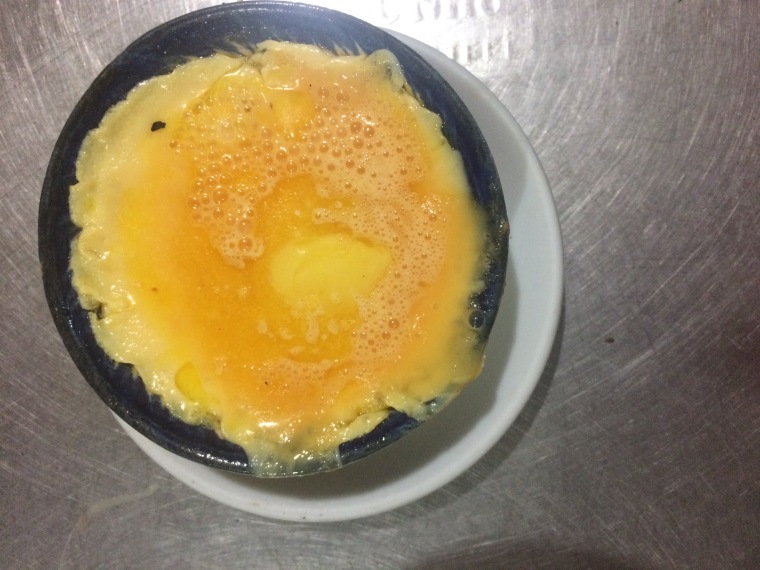
Uh nee = this one
Neung = one
If you’re a picky eater the best advice I can give you is to not be.
2. If you like spicy…
Tell them! Aggressively. My experience has been that street vendors and Thai people try to protect us weak fair-skinned people from spice, therefore they water everything down. This is done with good intentions, but I would prefer not to be deprived of my spice.
The first time I was served blood soup I didn’t know it was blood soup, and this is when I was fresh off the plane. The guy made me get blood soup instead of something else because it was “spicy.” Little does he know that most Americans would actually be more horrified to be served an unknown bodily fluid than something spicy.
If you want spicy, say “phet!” If you want really spicy, say “phet mak!”(spicy very) If you want really REALLY spicy, say “phet mak mak!”(spicy very very) And then throw in a “JING JING” (really really) if they still look at you funny.
If you’re ordering something like a som tam spicy papaya salad, you can specify how many chilies you want them to add. To do this, you say “_____ prik.” (Prik = chili peppers)
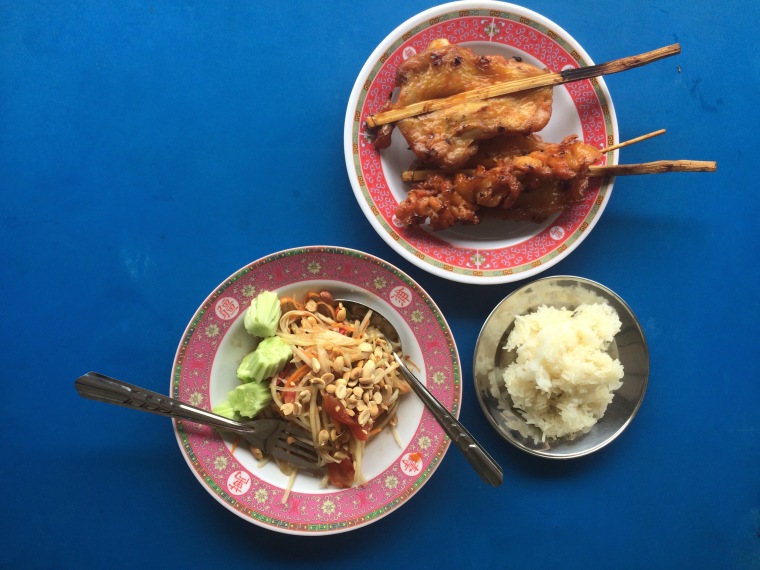
I usually go with sohng prik, or two chili peppers, but I like heat.
3. You can guess what they serve by what’s hanging in the stall window

Khao men gai, or steamed chicken with rice, is a staple. It usually comes with broth and ginger sauce, sometimes blood pieces, and sometimes added chicken fat in the rice. It’s amazing, I eat it at least 4 times a week, and it’s the only thing I ate for lunch during my first 3 months at Banhan because it was all I knew how to order. You can always recognize khao men gai by the steamed chickens hanging in the window. You’ll know they’re chickens because they still have the head attached.
Som tam is recognizable by tomatoes, green papaya, Chinese long beans, and sometimes salted eggs sitting in the stall window.
 Soups are recognizable by soup bowls and a big vat of broth, along with red pork and other items sitting in the stall window. I’d go into detail on soup but that could be a post on its own.
Soups are recognizable by soup bowls and a big vat of broth, along with red pork and other items sitting in the stall window. I’d go into detail on soup but that could be a post on its own.
4. If you’re vegetarian…
…and you’re super strict about it the food stalls probably aren’t really your gig. Harsh but I’m being honest. Thailand is not very vegetarian-friendly, especially when you throw in the language barrier. If you won’t get your panties in a bunch over a little piece of meat or chicken broth getting in your food, then welcome to the party, you’ll be fine. The only street food I can think of that is veggie-friendly is pad pak(stir fried veggies) or som tam(spicy papaya salad), and even som tam has prawns in it sometimes.
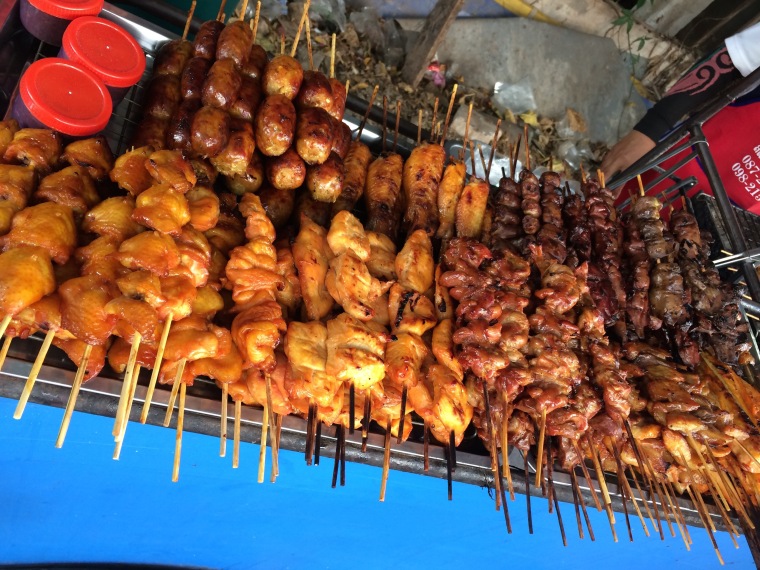
Mai gin neua (myyy ghin newwww-uh) – I don’t eat meat, AKA I’m vegetarian.
5. Paying
Paying when you don’t know numbers can be kind of difficult. When I first got here, I went with the reliable “hand them a 100 baht note and hope for the best” method. I’ve never seen a street vendor rip anyone off ever in Thailand(that I knew of), so it should be safe. Standard street meals cost about 25-50 baht in Dan Chang, probably about 40-65 baht in Bangkok.
If you want to ask how much, say “tow rai?”
6. If you’re feeling really adventurous with your Thai…
If street stalls have a menu written out in Thai, ask whoever’s working to read it to me in Thai to see if I recognize the names of the dishes. To do this, you point to the writing you want them to read and say “pood passa tai?” (speak language Thai)
Or you can ask stalls if they have things. This is what I do when I try new restaurants. I just go down the list of staples that I know most restaurants have and let jesus take the wheel.
To do this, you say “Mee ____ mai?” or “Do you have ____?”
Ex. “Mee Tom Yum Kung mai?” = Do you have seafood Tom Yum soup?
“Mee Pad Kra Pow Gai (basil chicken, HUGE staple) mai?” = Do you have basil chicken?
If they have it, they’ll say “Mee.” If they don’t, they’ll say “Mai mee.” The Thai language is so simple grammatically, it’s wonderful.
7. Throw an egg on it
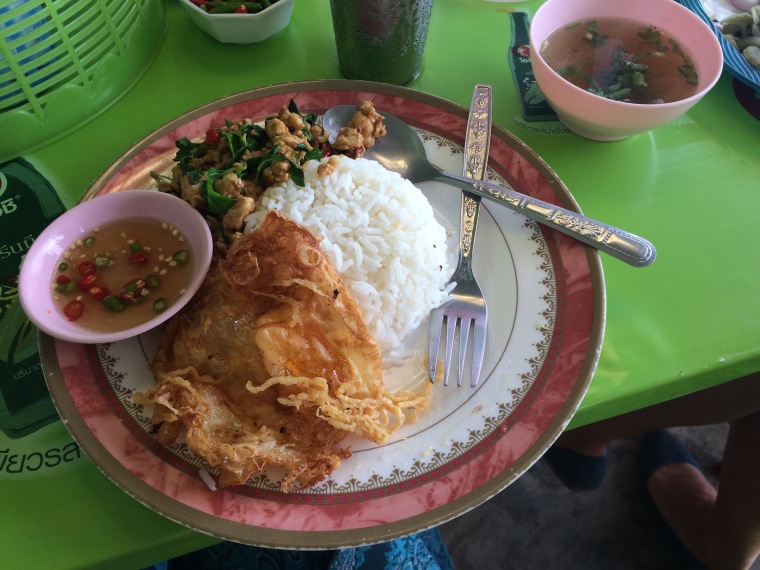
Many street food dishes that come with rice also have the option of adding a fried egg, for example Pad Kra Pow Gai(basil chicken). If you want a fried egg, say “Kai dow.” It’s usually just an extra 10 baht.
8. Taking things to go
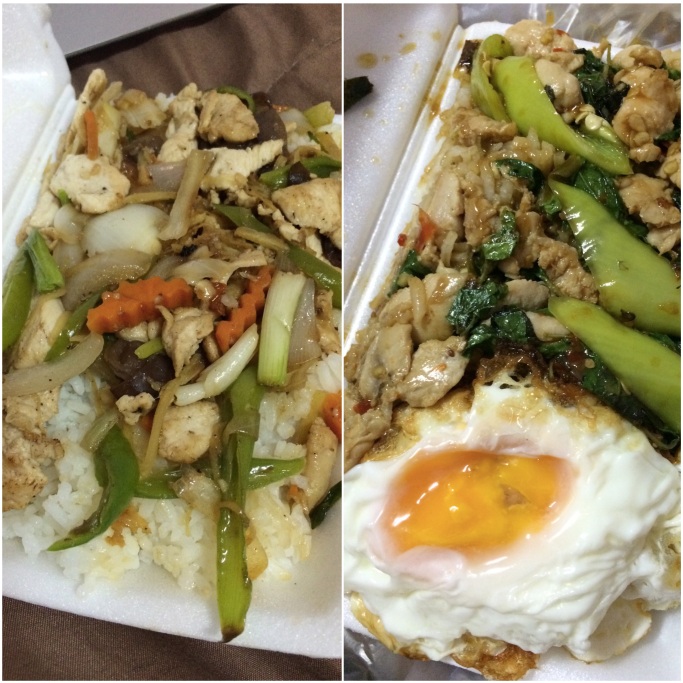
At pretty much any stall in Thailand you can take your meal to go. If it’s something that comes with rice or makes sense in a Styrofoam box, you say “sai gon.” Similar to the Vietnamese city.
If you want soup or som tam or anything that makes sense in a bag, you say “sai toon.” I just learned recently that there’s a difference, but whenever I’ve said sai gon in the past vendors have still been able to figure out what I want. Do a little pantomiming and you’re good to go.



Great post! Made me very hungry for Thai food!
LikeLike
Thank you!!!
LikeLike
Just a little add-up about the vegetarian part, “mai gin neua” means “I don’t eat beef.” Which basically could mean you are ok with pork or seafood, cause some Thai Buddhist don’t eat beef but they do eat pork. Cheers! 🙂
LikeLike
Ahhhh that makes sense. Thanks!
LikeLike